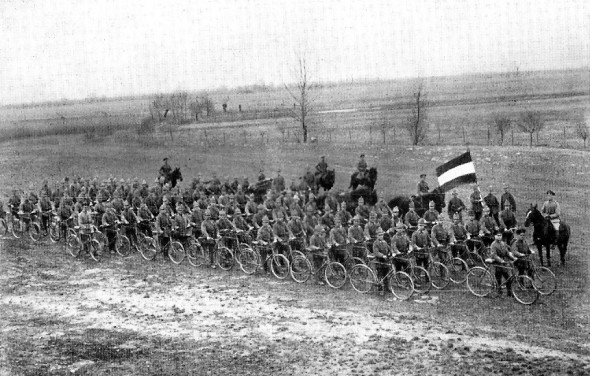If our only hope of survival is halting climate change, then the only way the human race will truly advance is if we get rid of war. That's what I believe, anyway.
That said, I also understand that you can't ignore war if you study history. So, because I am interested in history, and the roles the bicycle has played in it, I've written a few posts about how bicycles have been used by the military.
World War I may have been the conflict in which the bicycle played the most pivotal roles. It raged at exactly the moment when technologies spawned directly and indirectly by the bicycle were starting to take forms we recognize today. In all of the nations involved, with the exception of the United States, millions of people rode to work and school, and for fun. Even in the States, many of adults were still riding, as affordable, reliable automobiles (think Model T) were still a decade in the future.
Doran Cart is one person who recognizes the importance of bicycles in the so-called "Great War". He is the senior curator of the National World War I Museum and Memorial in Kansas City. When the US entered the war in 1917, military leaders "realized bicycles could make a difference in certain situations," according to Cart.
Although they weren't particularly useful in the trenches and weren't particularly safe on open roads, bicycles could reach areas inaccessible to motor vehicles, and were more reliable. These factors also made the bicycle, in many situations, the quickest way to convey messages. Bikes also were used, interestingly, on airbases.
What might have been as important as the bicycle's utility was its familiarity. Unlike other technologies deployed during the war, almost everyone was familiar with the bicycle, as most rode them as civilians. This meant that soldiers didn't have to learn how to use them, as they did with, say, trucks or planes. Because so many men and women in uniform had been riding bicycles for all or most of their lives, at least some knew how to repair and maintain them. How many people knew how to fix a plane or tank before the war?
That familiarity, according to Cart, also made bicycles useful in another way: they were "a humanizing aspect to the war." Because bicycles "represented something that every person could use" and were (and are) "available to everyone regardless of social class", they turned out to be rather effective propaganda tools. Countless illustrations from that time depict young soldiers on or with their bicycles. I mean, if you see this "Avanti Savoia" ("Onward Savoy"), you might think the 26th Bersaglieri Battalion was embarking on a bike tour.
That said, I also understand that you can't ignore war if you study history. So, because I am interested in history, and the roles the bicycle has played in it, I've written a few posts about how bicycles have been used by the military.
World War I may have been the conflict in which the bicycle played the most pivotal roles. It raged at exactly the moment when technologies spawned directly and indirectly by the bicycle were starting to take forms we recognize today. In all of the nations involved, with the exception of the United States, millions of people rode to work and school, and for fun. Even in the States, many of adults were still riding, as affordable, reliable automobiles (think Model T) were still a decade in the future.
Doran Cart is one person who recognizes the importance of bicycles in the so-called "Great War". He is the senior curator of the National World War I Museum and Memorial in Kansas City. When the US entered the war in 1917, military leaders "realized bicycles could make a difference in certain situations," according to Cart.
 |
| French military folding bicycle |
Although they weren't particularly useful in the trenches and weren't particularly safe on open roads, bicycles could reach areas inaccessible to motor vehicles, and were more reliable. These factors also made the bicycle, in many situations, the quickest way to convey messages. Bikes also were used, interestingly, on airbases.
What might have been as important as the bicycle's utility was its familiarity. Unlike other technologies deployed during the war, almost everyone was familiar with the bicycle, as most rode them as civilians. This meant that soldiers didn't have to learn how to use them, as they did with, say, trucks or planes. Because so many men and women in uniform had been riding bicycles for all or most of their lives, at least some knew how to repair and maintain them. How many people knew how to fix a plane or tank before the war?
That familiarity, according to Cart, also made bicycles useful in another way: they were "a humanizing aspect to the war." Because bicycles "represented something that every person could use" and were (and are) "available to everyone regardless of social class", they turned out to be rather effective propaganda tools. Countless illustrations from that time depict young soldiers on or with their bicycles. I mean, if you see this "Avanti Savoia" ("Onward Savoy"), you might think the 26th Bersaglieri Battalion was embarking on a bike tour.
















